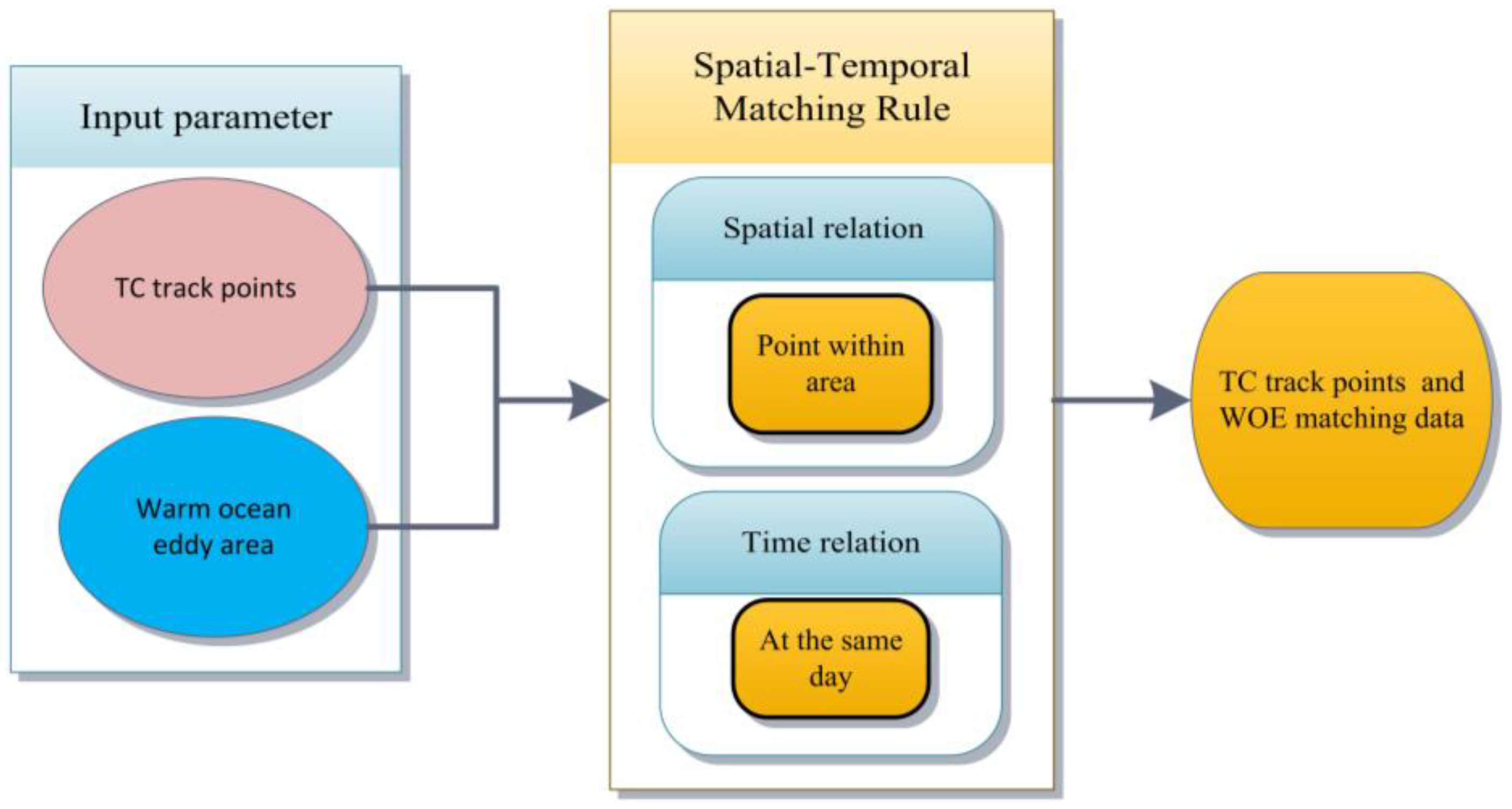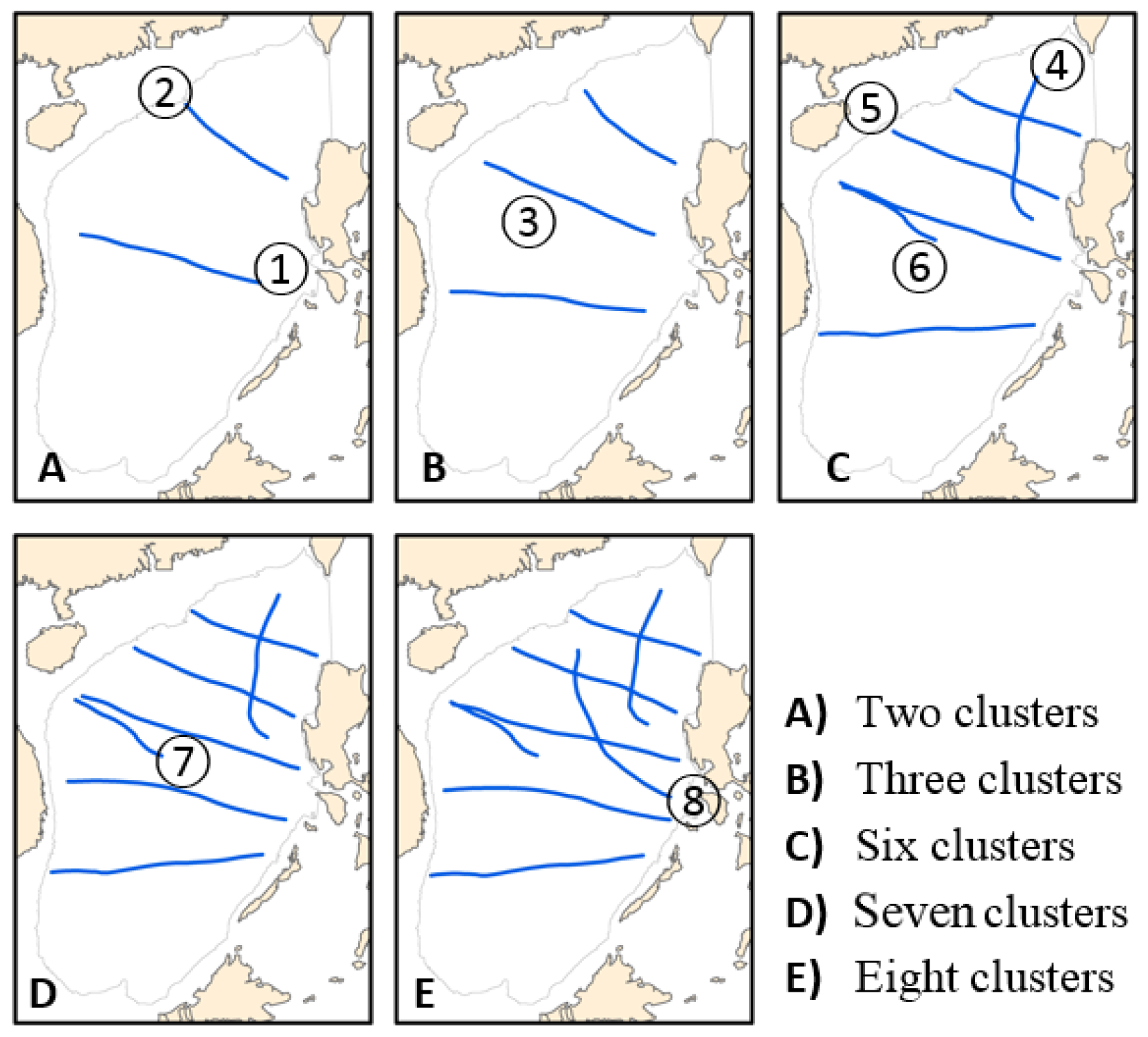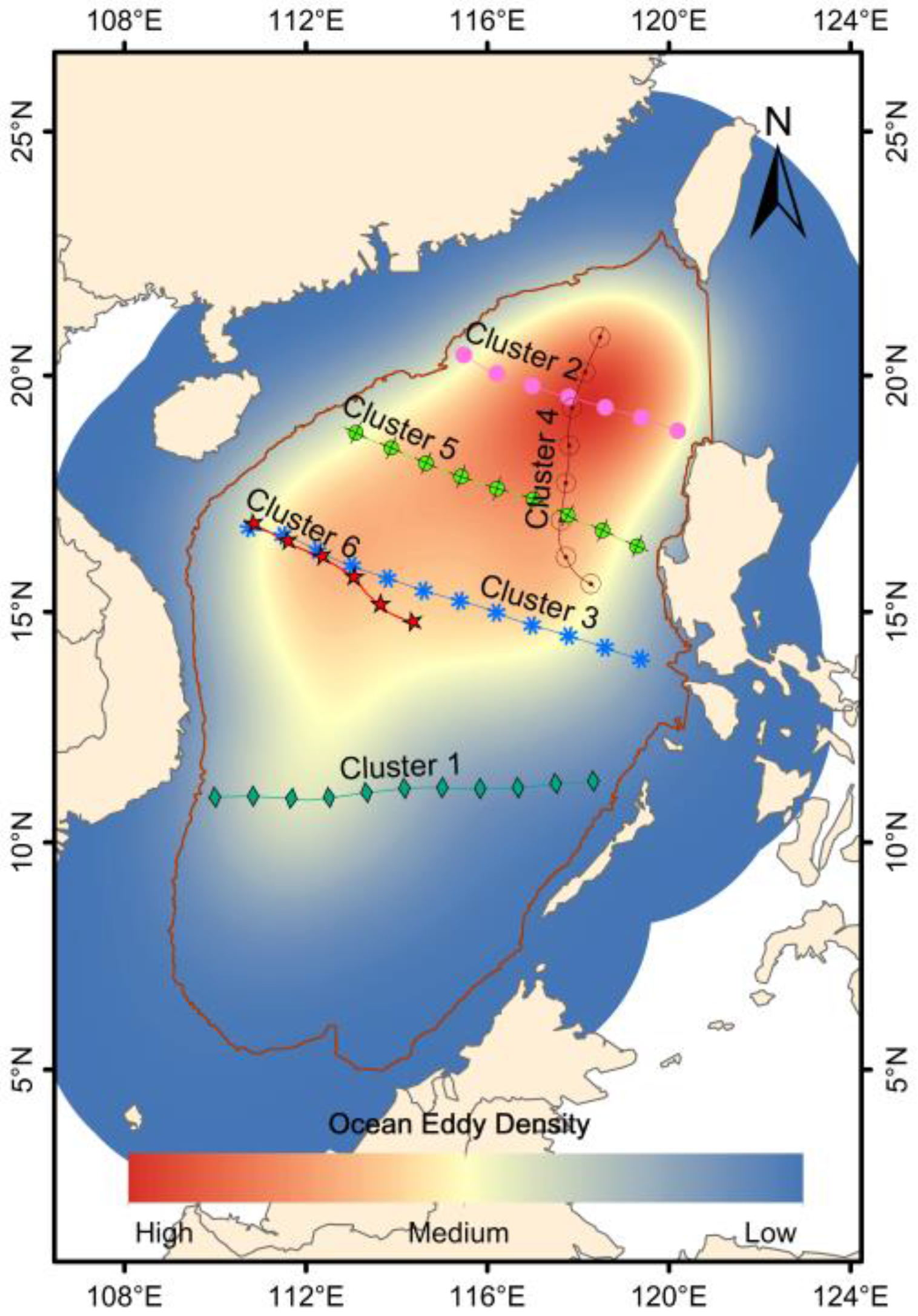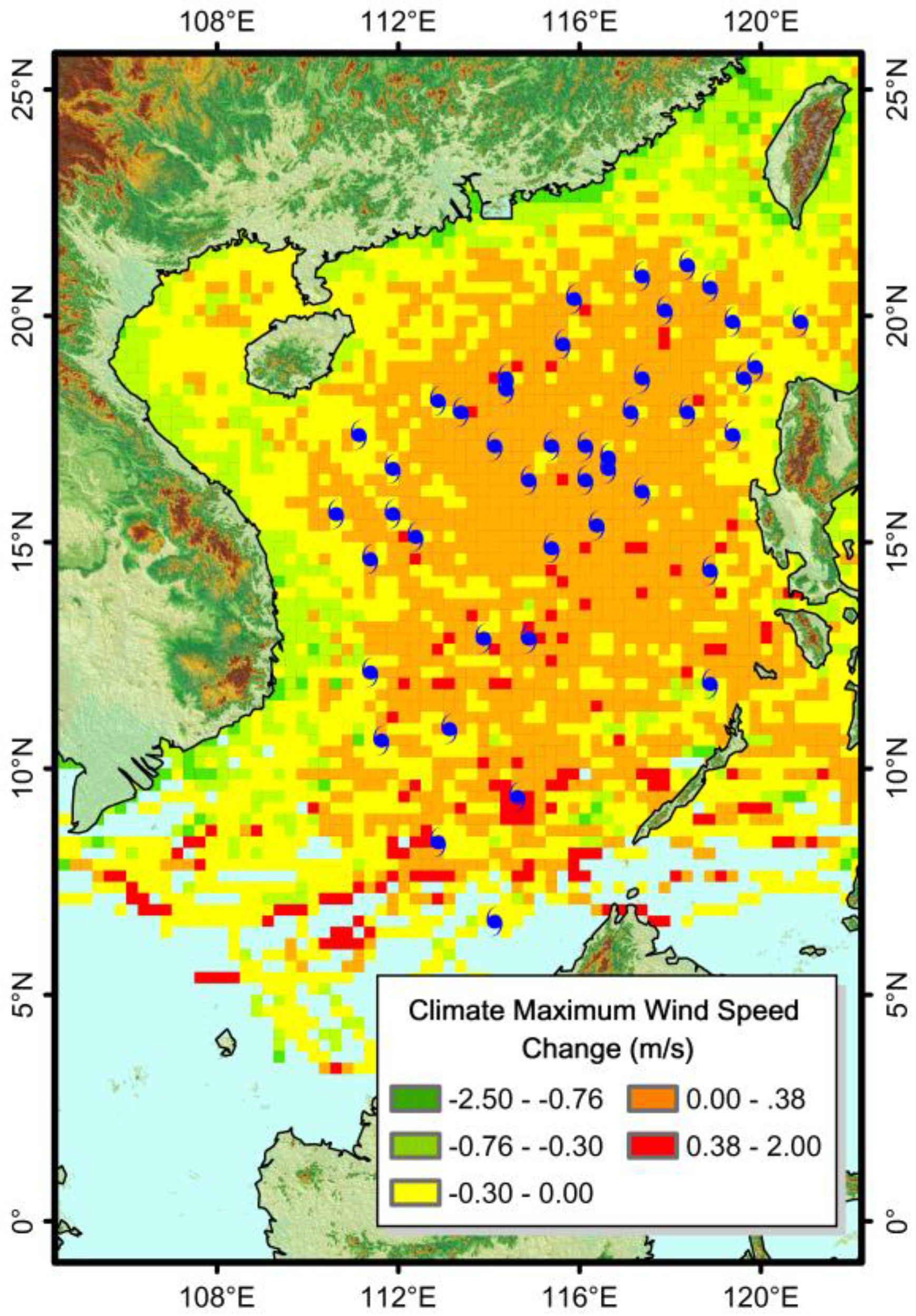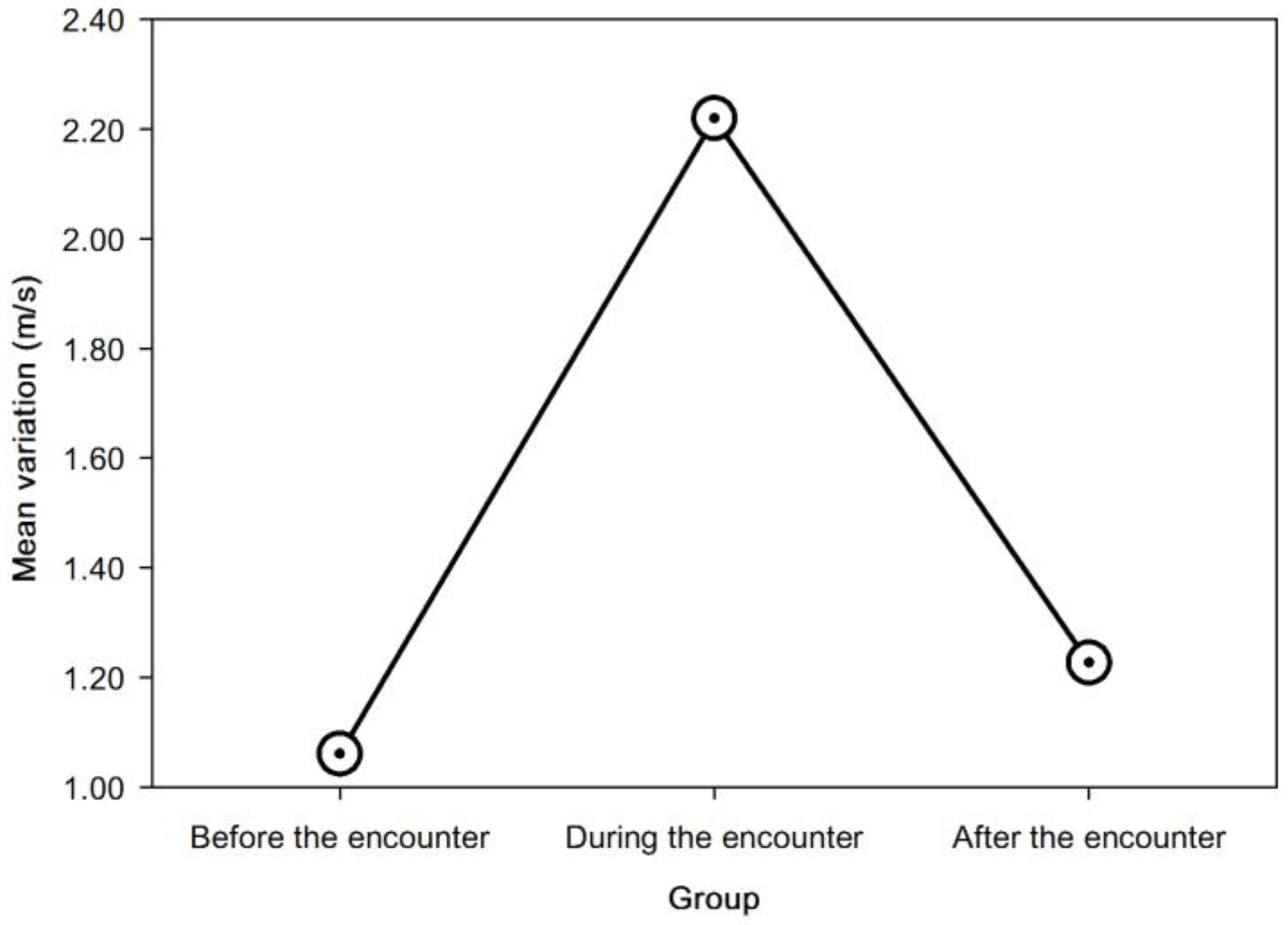1. Introduction
Tropical cyclones (TCs) are a common natural phenomenon that usually cause devastating disasters and, thus, significantly affect human social and economic activities. After a TC makes landfall, it usually causes significant loss of life, damage to city infrastructure, and ecosystem destruction. For example, when Katrina swept across the northern Gulf Coast of the United States, it caused about 1500 deaths and a total damage of about $81 billion [
1]. In the Western Pacific Ocean, the super typhoon Maemi, in 2003, was the most destructive TC. The storm surge produced by Maemi claimed approximately 130 lives and caused $5 billion in property damage in Korea [
2]. The TC Nargis was one of the most devastating natural disasters in the North Indian Ocean in recent years; bringing approximately 600 mm of total rainfall and a storm surge 3–4 m high, flooding the low-lying and densely populated Irrawaddy River delta. The deaths and missing persons toll from Nargis exceeded 130,000, and the economic losses were more than $10 billion [
3,
4].
Predicting the tracks of TC as well as their intensity changes along these tracks is of great value to society. A few systems have been developed and utilized successfully to track TCs, such as the Global Forecast System (GFS) of the National Oceanic and Atmospheric Administration (NOAA), the NOAA/Geophysical Fluid Dynamics Laboratory’s (GFDL) regional hurricane forecasting system, the U.S. Navy Operational Global Atmospheric Prediction System (NOGAPS), the European Centre for Medium-Range Weather Forecasts (ECMWF) model, and the Met Office model (UKMET) [
5]. However, in the past decade, the ability to forecast TC intensity changes has continuously lagged far behind the ability to forecast their paths [
5,
6]—mainly because TC intensity changes are affected by a multitude of factors [
7,
8,
9,
10,
11]. One significant factor is the sea surface temperature in the regions over which a TC passes.
Previous studies have reported sudden and unexpected intensification of TCs passing over warm ocean areas such as ocean currents and warm ocean eddies [
8,
12,
13,
14,
15,
16]. For example, in 1995, Hurricane Opal strengthened from 965 to 916 hPa within 14 h after encountering a warm ocean eddy in the Gulf of Mexico. The intensification process can be attributed to both the upper-ocean thermal structure and to lower atmospheric anomalies. However, the former tends to play a more important role than the latter in its effect on TC intensity variations [
17,
18]. Warm ocean eddies possibly serve as a heat reservoir to supply heat energy that intensifies passing TCs. They may also act as an effective insulator between TCs and the deeper cold ocean water [
19,
20]. Warm ocean eddies are characterized by a distinctly deep and thick 26 °C isothermal layer, whose characteristics could be used to measure hurricane heat potential [
21]. When a TC encounters a warm ocean eddy, the upper-ocean mixed layer of the warm ocean eddy tends to prevent the cold water beneath from upwelling; consequently, the sea surface temperature does not drop as significantly as in areas lacking warm ocean eddies. Such an effect has been identified from both observation data and from the results of numerical experiment [
12,
13,
18,
19,
22,
23,
24,
25,
26,
27,
28,
29]. For example, as Hurricane Opal swept across the Gulf of Mexico, post-storm sea surface temperatures (SST) fell by approximately 0.5 °C and 2 °C in the areas with and without warm ocean eddies, respectively.
Ocean eddies, which are ubiquitous ocean phenomena [
30,
31], play an important role in transporting and exchanging both physical and chemical constituents (i.e., heat, momentum, mass, chlorophyll) within oceans [
32,
33,
34]. Both warm and cold ocean eddies may modify the upper-ocean mixed layer. These typically affect TC intensity variations in totally opposite ways: warm and cold eddies tend to intensify and weaken passing TCs, respectively [
18,
35]. In this study, we focused primarily on the relationship between warm ocean eddies and TCs.
Numerical modelling results provide important insights about the influences of warm ocean eddies on TC intensity changes [
12,
13,
19,
22,
23,
24]. Currently, the interaction processes between warm ocean eddies and TCs can be simulated using hurricane-ocean coupled models such as the Coupled Hurricane Intensity Prediction System (CHIPS) model [
19], the axisymmetric hurricane model and the four-layer ocean model [
22]. These modelling results can be used to evaluate the effects of different factors on TC intensity and reveal the physical mechanisms that drive the interactions between these two phenomena. However, the modelling results tend to vary on a case-by-case basis; therefore, they cannot be used to investigate the interactions between warm ocean eddies and TCs over a broad area.
Vianna et al. [
29] conducted a case study to evaluate how warm ocean eddies affected Hurricane Catarina using Argo data and high-resolution satellite-derived data including ocean surface wind, sea surface height and SST. They concluded that warm ocean eddies intensified Hurricane Catarina, although, unlike numerical modeling, this type of case study is unable to evaluate how individual factors affect TC intensity variations.
Oropeza et al. [
36] used the National Hurricane Center’s archived best-track data from 1993 to 2009 to study how warm ocean eddies rapidly strengthened TCs in the northeastern Tropical Pacific. The statistical analysis results showed that warm ocean eddies are favorable to strengthening TCs. They concluded that the local heat exchange between the ocean and the TC increased when a TC swept over a region with warm ocean eddies. They also estimated the change in ocean heat content in response to warm ocean eddies using an algorithm developed by Goni et al. [
37] and Shay et al. [
12]. However, this study suffers from a few limitations. First, as the authors noted, it is not appropriate to simply use the heat content of the water to identify warm ocean eddies. Second, defining the extent of a warm ocean eddy based on high water heat content and positive sea surface anomalies is not a scientifically strict approach. Thus, it would be of great value, as we did in this study, to examine the interactions between TCs and warm ocean eddies using more rigorous methods based on more clearly defined criteria [
38].
Geographic information systems (GIS) technology has superior spatial data management, analysis, and presentation capabilities [
39] and has been widely used in urban transport planning [
40,
41], environmental studies [
42], disease spreading models [
43], and disaster response fields [
44]. GIS has also been employed in meteorology to forecast typhoon tracks [
45]. Both TC tracks and warm ocean eddies have spatial characteristics and thus can be translated into spatial data and then examined in GIS to reveal the spatial distribution patterns of the interactions between warm ocean eddies and TCs over a broad area.
This study uses a long-duration time series (1993–2013) dataset of warm ocean eddies and TCs to examine the interaction between these two types of phenomena. In addition to evaluating the effects of warm ocean eddies on TC intensity changes, and further to validate results from previous studies; however, over a much broader area (i.e., the South China Sea (SCS)).
5. Conclusions
This study examined the distribution of TCs in the SCS and their interrelationships with warm ocean eddies. From 1993 to 2013, we found 134 TCs that interacted with warm ocean eddies for at least a brief period. The tracks of these 134 TCs were grouped into six clusters, most of which are located in the northern SCS.
More than half (~57%) of the 134 TCs showed no intensity change after encountering warm ocean eddies in the SCS. Approximately 9% and 34% of the TCs weaken or intensify, respectively, after interacting with a warm ocean eddy. Although the majority of intensifying TCs (~82%) show intensity change values within a narrow range between 0.00 and 3.00 m/s, the difference in intensity is statistically significant.
The intensity change also varies among different categories of TCs. Both tropical storms and depressions tend to intensify more than typhoons; the former two types of TCs tend to have more potential to intensify, whereas the stronger typhoons tend to decay.
We further examined the temporal variations in TC intensity during the 6-h period before and after a TC meets a warm ocean eddy as well as during the interaction period between a TC and a warm ocean eddy. The differences in intensity changes during these three periods are statistically significant at a 6-h interval but not at a 12-h interval. Consequently, the temporal variations in TC intensity are remarkable only over a short time period—approximately 7 h, which is the average span of interactions between TCs and warm ocean eddies in the SCS.
We also found that the differences in the average SST of warm ocean eddies that encounter intensifying or unchanged TCs as well as those that encounter either weakening or non-weakening TCs are both statistically significant. Moreover, the high mean SST of the warm ocean eddies that encounter intensifying TCs probably indicates that higher SST helps intensify passing TCs. The sizes of warm ocean eddies may also contribute to TC intensifications in the SCS; however, their contribution might be limited due to the relatively small sizes of warm ocean eddies in the SCS compared to the radii of the maximum winds of TCs.
